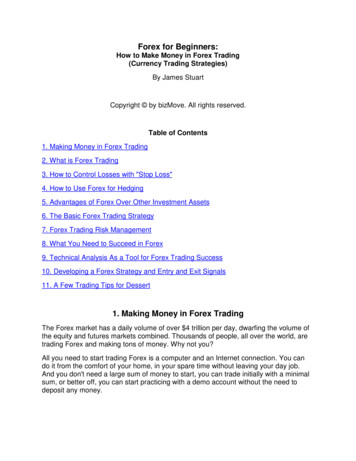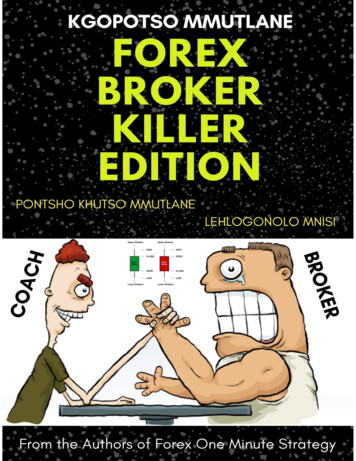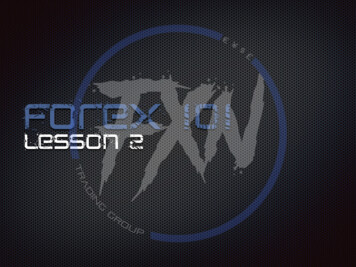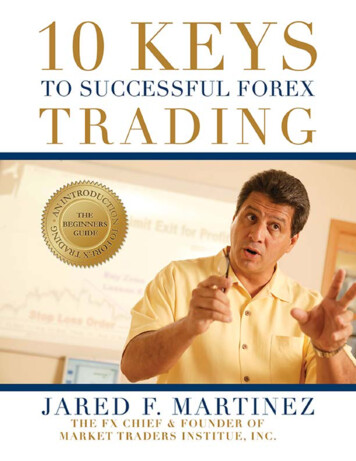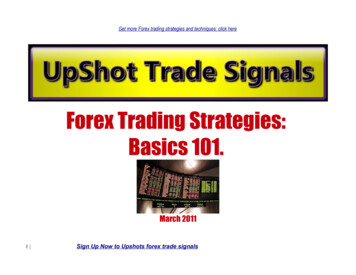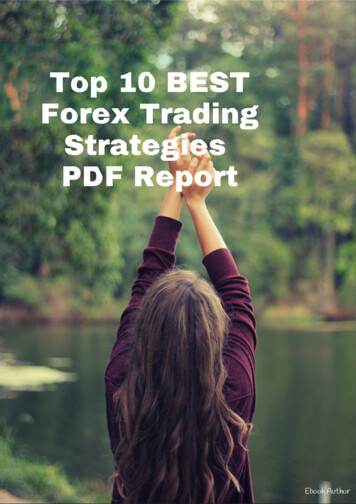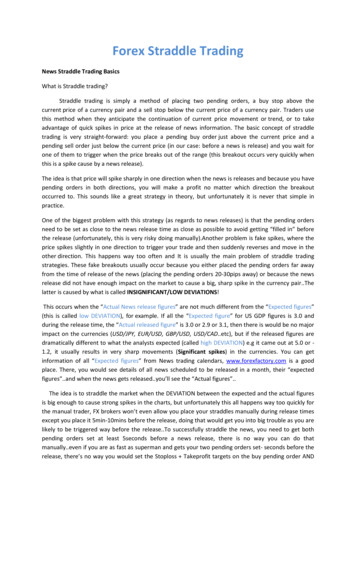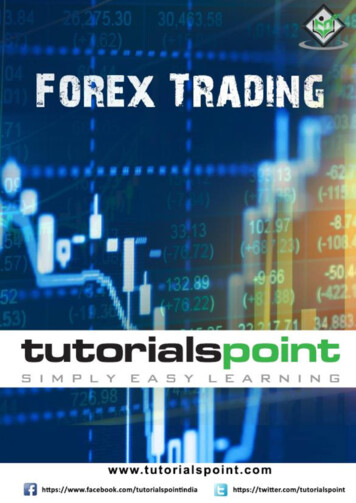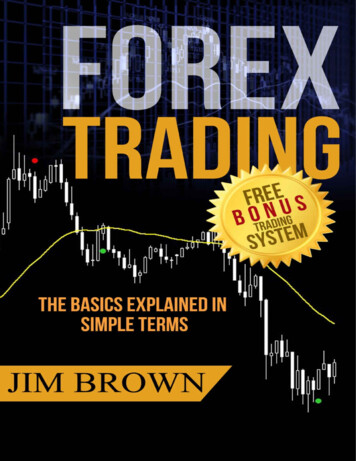
Transcription
Forex TradingThe BasicsExplained in Simple TermsPlus FREE BonusTrading System
Copyright 2015 by James Brown - All rights reservedThis book is geared towards providing information in regards to the topic and issuecovered. The publication is sold with the idea that the publisher is not required torender accounting, officially permitted, or otherwise, qualified services. If advice isnecessary, legal or professional, a practiced individual in the profession should beordered.From a Declaration of Principles which was accepted and approved equally by aCommittee of the American Bar Association and a Committee of Publishers andAssociations. In no way is it legal to reproduce, duplicate, or transmit any part ofthis document in either electronic means or in printed format. Recording of thispublication is strictly prohibited and any storage of this document is not allowedunless with written permission from the publisher. All rights reserved.Respective authors own all copyrights not held by the publisher. The trademarks thatare used are without any consent, and the publication of the trademark is withoutpermission or backing by the trademark owner. All trademarks and brands withinthis book are for clarifying purposes only and are the owned by the ownersthemselves, not affiliated with this document.
DisclaimerThis book is designed to provide information that the author believes to be accurateon the subject matter it covers, but it is sold with the understanding that neither theauthor nor the publisher is offering individualized advice tailored to any specificportfolio or to any individual’s particular needs, or rendering investment advice orother professional services such as legal accounting advice. Professional servicesshould be sought if one needs expert assistance in areas that include investment,legal, and accounting advice.There is a substantial risk of loss associated with trading these markets. Losses canand will occur. No system or methodology has ever been developed that canguarantee profits or ensure freedom from losses. No representation or implicationis being made that using this information will generate profits or ensure freedomfrom losses. The trade examples provided were hypothetical only and wereprepared with the benefit of hindsight. No hypothetical trading record cancompletely account for the impact of financial risk in actual live trading.Additionally, this book is not intended to serve as the basis for any financialdecisions, as a recommendation of a specific trading system. Your personalfinancial circumstances must be considered carefully before investing or spendingmoney.No warranty is made with respect to the accuracy or completeness of theinformation contained herein, and both the author and the publisher specificallydisclaim any responsibility for any liability, loss or risk, personal or otherwise,which is incurred as a consequence, directly or indirectly, of the use and applicationof any of the contents of this book and the bonus system.
IntroductionI hope you find this book useful to gain an understanding of the basics of forextrading and with this information; you become a successful trader in your ownright.My knowledge of currency trading extends over a 14 year period and has evolvedfrom the old fashioned manual charting when I first started in 2002, to trading onmultiple screens and entering the arena of automated trading. During this time, Ihave developed and shared many trading systems for free, and I have also assistedmany new Traders through my various blogs and forum participation.This book is for those of you who are just starting to consider trading Forex butdon’t know where to start, given the abundance of information on the internet. It isTHE first book to read to have an understanding of the very basics.I have deliberately kept the explanations quite simple and straightforward soeveryone can understand it.Best regardsJim
ContentsChapter 1 Welcome to the World of Forex TradingWhat is Forex?Why Forex?Advantages to Trading ForexWhen is the Forex Market Open?Chapter 2 What Do We Trade in the Forex Market?Forex Pairs - What do the Numbers Mean?Where do we Trade Forex?What About Choosing a Broker?Chapter 3 How Do You Actually Trade Forex?Important Information for US based TradersLot Size and Equivalent Pip ValueInformation on RiskChapter 4 Fundamental or Technical Analysis?News and Fundamental AnalysisTechnical AnalysisChapter 5 Further Information on Forex SpecificsRisk-Reward RatioTypes of OrdersHow Many Pips is Enough?Chapter 6 Trading PsychologyTrading PsychologyChapter 7 Time to TradeDay Trading or Longer Term Trading?Keeping a Journal or DiaryChapter 8 ConclusionBonus Trading SystemIntroductionTemplate and Custom IndicatorsMy Thoughts on TradingEntry SignalsTrade ManagementConclusion
Recommended ReadingRecommended Forums
Chapter 1Welcome to the World of Forex TradingSo you have heard about Forex Trading and you are now curious to check it out, butreally don't know where to start.Well you have come to the right place, as this book will take you through the basics,explain Forex in a plain and simple manner and give you enough information to getstarted sooner rather than later, in the exciting world of Forex Trading.What is Forex?Forex is the common term used to describe Foreign Exchange. It is also calledcurrency trading, or just FX trading, and every now and then you may see itreferred to as Spot FX.It is essentially the trading of the world's various currencies. Trading currencies is alittle different to trading shares or stocks, as currencies are traded against eachother. What I mean by this is that you are comparing one country's currency toanother country's currency. It is not as confusing as it sounds, so bear with me.Why would I want to trade Forex?Good question! Most people have heard about trading stocks, maybe even futuresand options. They have been around for years and your grandparents may have eventraded them. But I guarantee you that they wouldn't have traded Forex, unless theywere exceptionally wealthy individuals or worked for a major bank.It is only in the last 15 or so years that the retail Forex industry has opened up to thelikes of you and I, where you can start trading with a very small deposit into abrokerage account. Obviously the popularity of the internet has helped create thisboom as about 99.9% of all transactions are carried out online.Why Forex?For a start, it is by far the most liquid market in the world that runs 24hrs a day for 51/2 days of the week. Just to give you an idea of what I mean, in early 2014 andaccording to the Bank for International Settlements, Forex trading increased to anaverage of 5.3 trillion dollars a day. To put this in perspective, this averages out tobe 220 billion per hour. In fact, it would take 30 days of trading on the New YorkStock Exchange to equal one day of Forex trading.These figures are huge! There is no other way to put it. But obviously that doesn'treally affect the average trader other than giving that trader very good liquidity,
which means if you want to buy or sell any of the top 10 currency pairs, there isnever an issue of that pair not being available to trade. Also with this much volumeon a daily basis, the average trader like you and I have absolutely zero chance ofinfluencing market direction.Advantages to Trading ForexBecause the Forex market is running continuously for 24 hours during the week,there is very little gapping, which can be a common problem with stock trading. Forexample you may have bought XYZ stock at 24.20 on Tuesday just before themarket close with a stop loss set at 23.50 to protect you against any major losses.During the night, when the market is closed, there is a major announcement thataffects the company trading as XYZ, and the market opens on Wednesday morning,with XYZ trading at 22.10. Not only has it gapped down 3.10 overnight, it has alsoopened 1.40 below your stop loss giving you a much bigger loss than you everanticipated.This rarely happens in Forex trading, but having said that it can happen, especiallyover the weekend as this is the only time the Forex market is closed. But it is rare! Ican give you one example where I was caught out on a weekend. Late 2003 I was inopen positions over the weekend where I was basically going against the US dollar,and then US troops captured Saddam Hussein. This was very positive for the USdollar, which then opened much higher on the Monday inflicting some financialpain my way. I have learnt my lesson and I am rarely in open positions over theweekend.As you will soon see, with regards to Forex trading, you only have a small amountof currency pairs to choose from. This is a very small basket compared to thenumber of stock choices you have. On the US stock exchanges, there are literallythousands of stocks to choose from. Here you have the problem of finding a needlein a haystack. You will see that your Forex choices are much, much narrower, hencethere is certainly a lot less searching and analyzing required. All of your efforts andconcentration can be targeted in a very narrow field, so you can get on with thetrading sooner than later.Once you have a look at a few different Forex charts, which I discuss later, you willsee some very nice smooth trends that seem to occur quite often. Now this issomething that you may not understand if you have never traded a financialinstrument before, especially if you have never looked at charts. For those stocktraders out there, you would be very aware of stocks that just get stuck in a rangefor what seems forever, or stock charts that show plenty of gaps and a general uglysort of look. I am not saying that Forex doesn't range. It does, trust me, but when itbreaks out it is normally something very good. You will understand this once youstart looking at the charts.
The low cost of trading is also important. Most trading is conducted electronicallyover the internet on your nominated broker's online account. The cost is minimalfor each trade as there is normally no commission involved, however you do haveto cover the spread. This will be explained shortly, but it can be very cheap to tradeconsidering some pairs now have less than one pip spread.Further to the low cost, you can open an account with a broker for a very smallamount, and in some cases, just a couple of hundred dollars. Granted you are notgoing to make millions from this, but it is a start. I will cover brokers later.Some Further Advantages of Forex TradingSo we need somewhere to trade and as stated earlier, this is all done online via theinternet. The good thing about this is that most brokers offer unlimiteddemonstration platforms where you can practice trading for as long as you likewithout risking any of your own money. This is brilliant if you want to try outdifferent trading methods and ideas. Commonly referred to as 'demo trading,' thereis no reason that you can't have both a 'live' and 'demo' account with the sameBroker. Just ensure you don't get them confused.Demo trading is quite a useful tool where you can try out different things etc, butplease be warned, trading on a 'demo' account is nothing like trading on a 'live'account as there is zero risk with a 'demo' account and therefore your emotions donot come into play at all. It is like walking across a plank of wood 6 inches abovethe ground, compared to walking across the exact same plank of wood ten stories upin the air. I'm sure your emotions would be different, and the same goes for trading.When there is real money on the line, you will think and act different! Trust me onthis.And to take this one step further, Forex data is live and it is free. Unlike a lot ofstock data where you have to pay a monthly data subscription fee or stuck with 15minute delayed data, your Forex data is all freely provided to you by your chosenbroker's trading platform. I’ll have more on brokers and their platforms later.When is the Forex Market Open?Here I will discuss the trading times and as you will see, there is ample time to tradeForex. As stated earlier, it is a market that is open longer than it is closed. As mostpeople would be aware if you were trading stocks then you would trade thesethrough an exchange, whether it was the New York Stock Exchange or theAustralian Stock Exchange. Forex trading does not have any central exchange assuch. All trading is done through the banks or market makers, which are basically
the brokers that traders like you and I would use.Forex trading follows the world's time zones and is broken down into three majortime zones. The first to open is Asia, which includes New Zealand, Australia, Singapore,Japan etc. This is called the Asian session and is normally the quietest of thesessions with regards to trading volume. This is then followed by the European session. In the meantime, traders in theMiddle East are kicking in, and then all the major European centres, whereeventually London opens. The European session is the main session as it normallyhas the greatest volume traded. You have to remember also that London is thefinancial capital of the world, even though most people think it is Wall Street in theUS. The last session to open is the US session, and this session can also be veryfrantic, especially early in the day where there can at times, be major news releasesthat have a big effect on the US dollar itself. So we have the three trading sessions,which do overlap each other. There are no set times, just when banks open forbusiness in each major financial city and volume picks up.For me living in Australia, I know that during the day here, it is the Asian session,followed by the European session which kicks off at about 5pm, followed by the USsession at 11pm. I am normally in bed by 2am at the latest, which would be gettingclose to lunchtime in the US. In a nutshell, you can trade at any time, but if youintended on trading the London open and you lived in the US, you may have to setyour alarm clock and get up very early in the morning. Every time zone has itsadvantages and disadvantages.There are plenty of free online time zone clocks available that relate to the differentsession times, so it is quite easy to find a session or sessions that suit your lifestyle.You can also find free custom indicators that clearly put the different session timeson your trading charts. This is a great visual tool for some.
Chapter 2What Do We Trade in the Forex Market?Let's get into it!There are several currency pairs that can be traded, but the majority of traders juststick with a group of about 8 to 10 pairs. That is more than enough choice.First up, we have what they call the 'majors'. These are by far the most heavilytraded currency pairs, and a lot of traders are just happy trading one or two of these.The majors include:EUR/USDEuro dollar against the US dollarUSD/JPYJapanese yen against the US dollarGBP/USDGreat Britain pound against the US dollarUSD/CHFUS dollar against the Swiss francNotice how they are all against the US dollar, therefore when traders discuss thesepairs, they simply just refer to them as the Euro, Yen, Pound (or Cable) and theSwissy.Then we have what we call the '2nd tier pairs' and these include the following:AUD/USDAustralian dollar against the US dollarUSD/CADUS dollar against the Canadian dollarNZD/USDNew Zealand dollar against the US dollarAgain, these pairs are all against the US dollar, so they are simply referred to as theAussie, Loonie and Kiwi. The term Loonie actually comes from the first Canadiandollar coin.Then there are currency pairs which are simply called the 'crosses', and theseinvolve non US dollar pairs. Some of the more popular crosses include:
EUR/JPYEuro dollar against the Japanese yenGBP/JPYGreat Britain pound against the Japanese yenEUR/GBPEuro dollar against the Great Britain poundThere are quite a few others, but these three are probably the most popular traded. Alot of traders prefer to trade their home currency as they feel they have a betterunderstanding of it. Personally, I'm Australian, but I rarely trade the Aussie as I amvery comfortable trading the majors for the majority of my trades.So what do all the numbers mean when the currency pairs are traded together?The first currency mentioned is what they call the ‘base currency' and it is beingcompared to the 2nd currency, which is called either the 'quote currency' or the'counter currency'.If I watch my local news, and near the end they have a very brief financial reportwhere the newsreader may say something like:"The Aussie dollar was down today against the greenback, reaching a low of 71cents"Basically what they are saying is that the Australian dollar has dropped in valuecompared to the US dollar, and that one Australian dollar is equivalent to 0.71 US.As the US dollar is the major currency of the world, you will find most financialreports will compare your local currency to it, and even some of the other majorssuch as the Euro or the Great Britain pound.Using this same example of the Aussie at 71 cents if I were to travel overseas, say tothe US where I would need US dollars, then I would be hoping for as high a rate aspossible so I get more for my Australian dollar. So if the exchange rate moved up to75 cents, then one Australian dollar would be worth 0.75 US.You may see the quote for the AUD/USD similar to this: 0.7125 / 0.7128I’ll explain shortly why there are two sets of numbers. But just looking at 0.7125,this shows how many units of the quote/counter currency are needed to buy onedollar of the base currency. In this case, the US dollar is the quote/counter currencyand the Australian dollar is the base currency, so US 0.7125 is equal to AU 1.00.So if I travelled to the US, then each Aussie dollar I have is worth about 71c US.Forex Pairs - What do the Numbers Mean?Let’s consider a pair example:
If the AUD / USD were quoted at 0.7125 / 0.7128, what exactly does this mean? The first figure of 0.7125 is called the 'bid' price The 2nd figure of 0.7128 is the 'ask' price The difference between these two figures is called the 'spread'If I wished to buy the Aussie, thinking that the Australian dollar is going to go up invalue compared to the US dollar, I would be required to pay the ASK price, which inthis case is 0.7128. On the other hand, if I thought the Aussie was becoming weakeragainst the US dollar and I wished to sell it, then I would sell it at the BID price of0.7125.Now if I was to buy the Aussie at 0.7128 and then immediately close my positionbefore the price had a chance to move, I would have to close the position by sellingthe Aussie at 0.7125.Now there is a difference of 0.0003, which is called the spread, and that would be theamount I lost on this trade. In the case of the Aussie, each 0.0001 move is called apip (or sometimes referred to as a point). So on this trade, I would have lost 3 pips(or 3 points).All the pairs I mentioned above, except the JPY pairs, normally have four decimalplaces, and their pip value is calculated the same as the above Aussie example. TheJPY pairs usually only have the two decimal places. An example of the USD/JPYcould be quoted as follows:97.81 / 97.83.This tells me that one US dollar is equal to approximately 97.8 Japanese yen.The bid price is 97.81 and the ask price is 97.83, and that there is a 2 pip spread. Inthis case each 0.01 move is called a pip.Important: Most brokers these days have an extra decimal place on their quotedprices. This has come about as the result of spreads becoming tighter over theyears.When I first started trading, a small spread on the EUR/USD was 3 pips, whereasnowadays it is common to see the spread on this pair at 0.8 of a pip or even less.Hence the addition of this extra decimal point on the quoted prices. If you see threeor five decimal places and depending on how precise your trading is, I wouldsuggest you just ignore the very last digit. That is the simplest way.For example if you saw a quote for the EUR/USD as 1.38641 / 1.38663, you wouldsimply read it as 1.3864 / 1.3866 by dropping the last digits. Then you can see thatyou have a spread of 2 pips. This is just to keep it simple. If you wanted to be
precise, then in this example you would simply take 4.1 away from 6.3 to give youan exact spread of 2.2 pips. These are just the last two digits on the quote where the2nd last digit is an actual whole number of pips, with the last digit representing afraction of a pip. It can be very confusing at first. Me, I just round it up or downdepending which side of 0.5 I am on, just to keep it very simple.Next, I'll discuss the different brokers and platforms available. This is a minefield initself!Where Do We Trade Forex?You will have to open an online brokerage account to enable you access thatbroker's trading platform. As I mentioned earlier, most brokers offer demo tradingwhere you can practice trading without risking real money – it’s a little like playingmonopoly. You do not need to deposit any funds with a broker to gain access totheir demo platforms, as most are quite willing to let you try them without anyobligation. This also gives you the chance to try various platforms and see what youfeel comfortable with.What About Choosing a Broker?This is a good question and you will get a variety of answers if you were to askaround in the trading community. Firstly, I would strongly suggest that you chooseone of the bigger well known brokers. Trust me on this!The retail forex industry is still relatively young and it does not have the sameregulations and rules to follow as a lot of other traded financial instruments. This ismainly due to the fact that there are no central exchanges involved. But having saidthis, a lot of governments are beginning to formulate rules and regulations that dogive forex traders better protection. But be warned, there are still bucket shops(dodgy brokers) out there who will rip you off in a heartbeat. It was only recently Iheard of one Swiss based broker disappearing with all their clients’ funds.I certainly don't want to scare anyone off, but please be warned and choosewisely. There are plenty of good brokers around, so there is no need to panic andget stressed about this.Another suggestion is that you do not place all of your funds into one broker,especially if you have a substantial amount. What I am talking about here, is if youhad say 100,000 to trade (which you don't need!), I wouldn't be depositing all ofthis with the one broker. Instead, I would either spread it amongst two or morebrokers, or keep funds in reserve and only deposit them with my broker if they wererequired - you will sleep better at night!
Important: In January 2015 there was a huge move by the Swiss National Bankwhere the Swiss franc was depegged from the Euro catching the financial marketsby surprise. This caused an insane, huge, untradeable price spike in Swiss francrelated pairs, which basically wiped out trading accounts or made some tradersextremely profitable. This spike also sent some very reputable major brokers to thewall financially, causing some to go broke or go into liquidation. Alpari UK wasone of the major players affected and is no longer in existence. FXCM alsostruggled but recovered. So be careful where you put your funds and only depositwhat is required.Many traders also like to keep their hard earned cash in their own country and I canunderstand this, and again it is just a perceived safety measure. Me personally, Ihaven't got a problem with dealing with overseas brokers. My past experiences haveproduced no problems at all transferring funds either way, so I am quite happy touse overseas based brokers. I didn't have a choice really as up to a couple of yearsago, there weren’t any Australian based brokers that I felt comfortable with, but thathas since changed.Not all broker trading platforms are the same and this is where it gets interesting.Every platform appears to have its advantages and disadvantages. You have to findsomething you are comfortable with. One of the most popular forex tradingplatform is Metatrader, or more commonly referred to as MT4. This platform isthen used by a variety of brokers. How this works, is that you would go to yourchosen broker's website, sign up with them, and then download the MT4 softwarefrom their site. Here you can either select demo or live trading or both. Obviouslythey will provide further instructions on how to deposit funds into your brokerageaccount.You can find out more about MT4 by doing a Google search on 'Metatrader'.I personally find the MT4 platform one of the best, especially for the charts. It isquite incredible what you can do with this platform. Even though the charts andother features are excellent on the MT4 platform, I am not particularly happy withthe way you place orders. It is not as easy as it should be and can be a littlefrustrating at times. But the charts are excellent, or did I already say that?Being an Aussie, I use GoTrader or Pepperstone for my MT4 platform and I amquite happy with both of them.The beauty of the MT4 platform is its popularity and the ability to write your owncomputer code to design your own custom indicators or expert advisors. There areeven dedicated forums and groups that just discuss this platform. Most tradingplatforms come with a variety of standard charting indicators. Things like MovingAverages, MACD, RSI, Bollinger Bands etc. Now with MT4, you can design your
own custom indicators and download them direct to your trading platform, and thenonto your charts. Don't worry if this sounds a little confusing at the moment as itdoes become clearer as you become more familiar with the platform. You don'tneed these custom indicators to trade, and if you are interested in trying them out,there are plenty of smart traders out there who have already done all the hard workand made them freely available online. There are thousands of them.I also mentioned expert advisors, commonly known as 'EAs' or 'Trading Robots'.This is a software program that is loaded onto your platform and then onto selectedcharts. A fully automated EA, once activated, will go to work to identify trades thatfit its trading criteria, open a trade without human involvement, manage the tradewithout human involvement and eventually close the trade without humaninvolvement. It all sounds too easy, doesn't it! Again you can design your own or letsomeone else do it for you. They are not as freely available as custom indicators,but they certainly are becoming more popular.Again, be warned! There are plenty of scammers out there selling trading robotsbased on outrageous promises of untold wealth. Do your due diligence and choosewisely if you decide to go down that path. The good ones are few and far between.MT4 is not the only platform you can customize indicators and trading systems, butit is by far the most popular. I have used CMS and their VT Platform in the past, andthey too have an excellent charting package.There are plenty of other good brokers around. One of my favourites is Oanda. Itdoes have a web based platform available as well as their MT4 platform. The webbased platform doesn’t require any software to be downloaded, which means youcan access this platform from any computer that is Java equipped. Oanda is a verypopular and reliable platform which offers very low spreads and is very simple touse. There is also one other big advantage using Oanda with regards to tradeposition size and it is one of the reasons I like them so much. They have also beenaround for a few years now and there are rarely any negative comments about them.Oanda is certainly a great beginner's broker and platform/s.You can find Oanda here at http://www.oanda.com/As stated earlier, there is no central exchange for Forex trading, therefore pricingon different currency pairs can vary at times between the different brokers.Normally all the good brokers will be within one or two pips of each other, whichreally isn't an issue. However every now and then, there will be a price spike on onebroker ’s charts but not on other broker ’s charts. Too bad if you had an order setaround where the price spiked, whether it be a buy/sell order or a stop loss. Thesetypes of fluctuations normally happen on the not so well known broker platforms. Ifyou stick with a decent broker, you will avoid these types of problems. I normallyrun two platforms together and can see the differing prices, but as they are two
reputable brokers, there is rarely an issue with price differentials.I mentioned the term the 'spread' earlier, which is the difference between the bid andthe ask prices. It was only a few years ago that the spread on the EUR and JPY were3 pips, and the other major pairs ranged from 4-5 pips, and this was happilyaccepted by all. Nowadays, it is not uncommon to get spreads on the EUR and JPYfor 1 pip or less, and the other majors, for less than 3 pips, as are a few of the 2ndtier pairs and crosses.The spread is your cost of doing business. For you to make any profit, you mustfirst make up the spread. For example, if you bought the USD/CHF at 1.0774 andyou had a 3 pip spread, then the price would have to rise to 1.0777 before you are ina break even position. Remember you buy at the ask price and sell on the bid price.So in this case, when you bought, the quote would have been 1.0771 / 1.0774. It thenhas to look like this before you can get out at breakeven 1.0774 / 1.0777, which is a3 pip increase in price.Some brokers maintain the same spread, albeit a little higher during all markethours, whilst other brokers may vary the spread depending on the volatility at thetime. What is volatility? It can be when the market is very quiet, like when themarket opens early in the week, or after hours at the end of the US session beforethe Asian session has cranked up. It can also refer to when there is very highvolume, nor
Welcome to the World of Forex Trading So you have heard about Forex Trading and you are now curious to check it out, but really don't know where to start. Well you have come to the right place, as this book will take you through the basics, explain Forex in a plain
